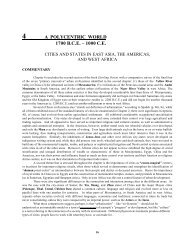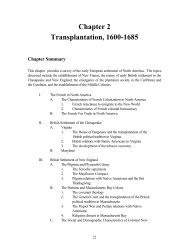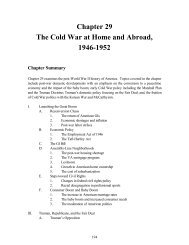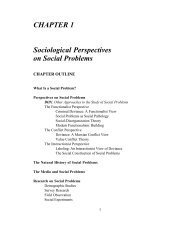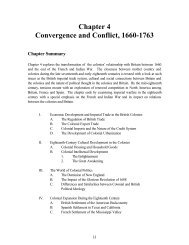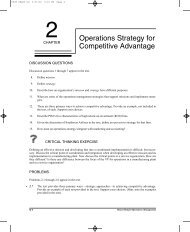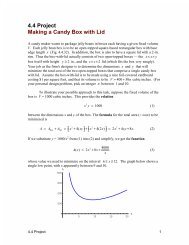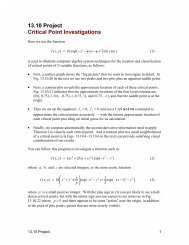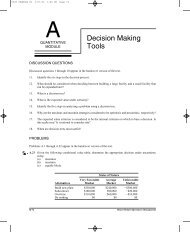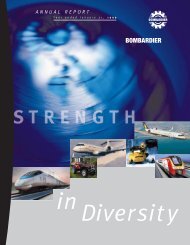Chapter 30 The Confident Years, 1953-1964
Chapter 30 The Confident Years, 1953-1964
Chapter 30 The Confident Years, 1953-1964
Create successful ePaper yourself
Turn your PDF publications into a flip-book with our unique Google optimized e-Paper software.
<strong>Chapter</strong> <strong>30</strong><br />
<strong>The</strong> <strong>Confident</strong> <strong>Years</strong>, <strong>1953</strong>-<strong>1964</strong><br />
<strong>Chapter</strong> Summary<br />
<strong>Chapter</strong> <strong>30</strong> examines the American transition from conservatism to liberalism during the late<br />
1950s and early 1960s. Topics considered in this chapter include the social history of the<br />
affluent fifties, the continuation of Cold War policy, the mystique and mistakes of the John F.<br />
Kennedy administration, the birth of the modern American Civil Rights movement, and Lyndon<br />
B. Johnson’s rise to the presidency.<br />
I. A Decade of Affluence<br />
A. What’s Good for General Motors<br />
1. Dwight Eisenhower and political moderation<br />
2. <strong>The</strong> impact of a booming economy<br />
B. Reshaping Urban America<br />
1. Urban renewal<br />
2. <strong>The</strong> Federal Highway Act of 1956<br />
C. Comfort on Credit<br />
1. <strong>The</strong> rise in consumer debt<br />
2. Large-scale suburban shopping malls<br />
3. <strong>The</strong> servants of America’s car culture<br />
4. <strong>The</strong> emergence of the high-intensity entertainment environment<br />
D. <strong>The</strong> New Fifties Family<br />
1. <strong>The</strong> social pressure for family life<br />
2. Television and the Youth Culture<br />
E. Turning to Religion<br />
1. <strong>The</strong> link between the government and God<br />
2. Radio and television preachers<br />
3. <strong>The</strong> resurgence of evangelical Christianity<br />
4. Growth in African American churches<br />
F. <strong>The</strong> Gospel of Prosperity<br />
1. Scholarly assessment of American prosperity<br />
2. American identity with affluence<br />
G. <strong>The</strong> Underside of Affluence<br />
1. Michael Harrington’s <strong>The</strong> Other America (1962)<br />
2. C. Wright Mills’ <strong>The</strong> Power Elite (1956)<br />
3. David Riesman<br />
202
4. Betty Friedan’s <strong>The</strong> Feminine Mystique (1963)<br />
5. <strong>The</strong> Beats<br />
II. Facing Off with the Soviet Union<br />
A. Why We Liked Ike<br />
1. A foreign policy president<br />
2. <strong>The</strong> “hidden-hand” presidency<br />
B. A Balance of Terror<br />
1. <strong>The</strong> doctrine of massive retaliation<br />
2. <strong>The</strong> intensification of public fear of nuclear war<br />
C. Containment in Action<br />
1. John Foster Dulles and “brinksmanship”<br />
2. <strong>The</strong> role of the third world<br />
D. Global Standoff<br />
1. <strong>The</strong> U-2 affair of 1960<br />
2. Unresolved issues from the Eisenhower administration<br />
E. John F. Kennedy and the Cold War<br />
F. <strong>The</strong> Kennedy Mystique<br />
1. <strong>The</strong> presidential election of 1960<br />
2. <strong>The</strong> Kennedy charisma<br />
G. Kennedy’s Mistakes<br />
1. <strong>The</strong> Bay of Pigs incident<br />
2. <strong>The</strong> Berlin Wall<br />
3. Increased American involvement in South Vietnam<br />
H. Missile Crisis: A Line Drawn in the Sand<br />
1. <strong>The</strong> events surrounding the crisis<br />
2. <strong>The</strong> reasons for Khrushchev’s actions<br />
I. Science and Foreign Affairs<br />
1. Areas of technological competition<br />
2. <strong>The</strong> Limited Test Ban Treaty<br />
III. Righteousness like a Mighty Stream: <strong>The</strong> Struggle for Civil Rights<br />
A. Getting to the Supreme Court<br />
1. Charles Hamilton Houston and the NAACP Legal Defense<br />
and Education Fund<br />
2. Brown v. the Board of Education<br />
3. Cases granting rights to Latinos<br />
B. Deliberate Speed<br />
1. <strong>The</strong> Southern Manifesto<br />
2. Problems with enforcement<br />
C. Public Accommodations<br />
1. <strong>The</strong> Montgomery bus boycott<br />
2. Martin Luther King, Jr. and the Southern Christian Leadership<br />
203
Conference (SCLC)<br />
3. <strong>The</strong> lunch counter sit-in in Greensboro, North Carolina<br />
4. Freedom rides<br />
D. March on Washington, 1963<br />
1. Continued struggle in Alabama<br />
3. <strong>The</strong> march on Washington<br />
IV. “Let Us Continue”<br />
A. Dallas, 1963<br />
1. <strong>The</strong> assassination of Kennedy<br />
2. <strong>The</strong> conspiracy theories<br />
B. War on Poverty<br />
1. Lyndon B. Johnson<br />
2. <strong>The</strong> issue of poverty<br />
C. Civil Rights, <strong>1964</strong>-1965<br />
1. <strong>The</strong> Civil Rights Act of <strong>1964</strong><br />
2. SNCC and Freedom Summer<br />
3. <strong>The</strong> march from Selma to Montgomery<br />
4. <strong>The</strong> Voting Rights Act of 1965<br />
D. War, Peace, and the Landslide of <strong>1964</strong><br />
1. <strong>The</strong> presidential election of <strong>1964</strong><br />
2. <strong>The</strong> Great Society<br />
VI. Conclusion<br />
Learning Objectives<br />
After a careful examination of <strong>Chapter</strong> <strong>30</strong>, students should be able to:<br />
1. Identify the candidates and outcome of the presidential election of 1952.<br />
2. Explain the meaning of the term New Republicanism.<br />
3. Discuss the growth of the American economy during the 1950s and explain its impact<br />
on America’s national image and the way in which the nation identified and characterized itself.<br />
4. Comment on the impact of economic growth on African Americans and Native<br />
Americans.<br />
5. Define the term urban renewal and describe how it transformed American cities.<br />
204
6. Outline the provisions of the Federal Highway Act of 1956 and explain the impact of<br />
massive road construction on American society and culture.<br />
7. Define the term teenager and explain the importance of the emerging youth culture in<br />
America.<br />
8. Discuss the connection between government and God during the 1950s and how this<br />
impacted the popularity of religion.<br />
9. Identify the major writers who challenged American affluence by revealing the limitations<br />
and dangers of national economic abundance.<br />
10. Explain Eisenhower’s doctrine of massive retaliation in terms of its impact on<br />
American foreign relations during the 1950s as well as in terms of its impact on increasing<br />
American fear of nuclear war.<br />
11. Identify the significance of the Soviet launch of the Sputnik and indicate the American<br />
response to that event.<br />
12. List the major examples of American intervention in third world political affairs during<br />
the 1950s.<br />
13. Explain the historical context for the future Vietnam conflict.<br />
14. Discuss the misunderstandings typical of Soviet-American relations during the 1950s<br />
focusing on the U-2 affair of 1960.<br />
15. List the failures of the Kennedy administration’s initial forays into foreign affairs in Cuba,<br />
Germany and Vietnam.<br />
16. Describe the events surrounding the Cuban missile crisis of 1962. Explain the reasons<br />
why Khrushchev was willing to take a risk in Cuba.<br />
17. Explain why the Limited Test Ban Treaty is considered one of Kennedy’s greatest<br />
achievements.<br />
18. Explain the historical significance of the Supreme Court decision in Brown v. Board of<br />
Education of Topeka.<br />
19. Explain the intent of the Southern Manifesto.<br />
20. List the crises occurring between 1954 and 1963 which indicated the difficulty of<br />
carrying out the Brown decision “with all deliberate speed.”<br />
205
21. Explain the historical significance of the Montgomery bus boycott.<br />
22. Discuss the role of Martin Luther King, Jr. in the American civil rights movement.<br />
23. Identify the term freedom rides and explain their relevance to the civil rights movement.<br />
24. Identify Bull Connor and explain his role in the civil rights movement in Alabama.<br />
25. Explain the historical significance of the 1963 March on Washington.<br />
26. Discuss the controversies surrounding John Kennedy’s assassination in 1963.<br />
27. Outline the major components of Lyndon Johnson’s “war on poverty.”<br />
28. Outline the major provisions of the Civil Rights Act of <strong>1964</strong>.<br />
29. List the major events and efforts associated with Freedom Summer.<br />
<strong>30</strong>. Describe the events leading up to, as well as the provisions of, the Voting Rights Act of<br />
1965.<br />
31. Explain the significance of the Gulf of Tonkin Resolution in escalating the American<br />
involvement in Vietnam.<br />
32. Identify Barry Goldwater and describe his political philosophy during the 1960s.<br />
33. List the major pieces of legislation enacted by Congress in the early phase of Johnson’s<br />
Great Society.<br />
Topics for Classroom Lecture<br />
1. Prepare a lecture on the emergence of a youth culture during the 1950s. One option is<br />
to focus on trends in popular music, particularly rock-and-roll. Connect the origins of<br />
rock-and-roll to the southern musical traditions of rhythm and blues, country, and gospel.<br />
Examine why early rock-and-roll was referred to as “race music” and why the white community<br />
responded with white “cover records.” Supplement the lecture with recordings of early<br />
rock-and-roll performers such as Little Richard and Chuck Berry as well as examples of cover<br />
records by performers like Pat Boone. How does Elvis Presley fit into the picture? Presley<br />
recorded cover records, but was he distinct from Pat Boone? How so?<br />
206
2. Examine the status of American women in the 1950s. How was the condition of middle<br />
class American women in the 1950s significantly different from earlier decades in the twentieth<br />
century? To what extent was the status of women in the 1950s defined by World War II?<br />
How did television and journalism impact the American middle-class woman’s self-image?<br />
How does the status of women in the 1950s and 1960s predict the need for a women’s<br />
liberation movement?<br />
3. Examine the political ideology of Lyndon Johnson. Focus on the political paradox of a<br />
southern politician who eventually played a pivotal role in realizing a liberal reform agenda<br />
including the most significant civil rights legislation since Reconstruction and one of the most<br />
ambitious programs addressing economic inequity in America since the New Deal. What<br />
factors in Johnson’s political background prepared him for this role? To what extent did interest<br />
in and loyalty to the Democratic party define his role? Ask students to comment on Johnson’s<br />
significance to southern politics and to national politics.<br />
Topics for Class Discussion and Essays<br />
1. As mentioned in <strong>Chapter</strong> 29, historians have characterized the 1950s as a decade of<br />
conservatism, consensus, and conformity. Yet, the 1950s preceded the 1960s which is<br />
characterized as one of the most radical and turbulent decades in modern American history.<br />
Have students discuss the fifties as the breeding ground for the sixties. Consider some of the<br />
following issues:<br />
a. <strong>The</strong> 1960s counterculture. Have students consider the baby boom and the<br />
emergence of the American teenager as predictors of this sixties phenomenon. Did the<br />
emergence of rock-and-roll, the Beat generation, and fifties affluence play a role in the<br />
emergence of a counterculture? Did the conservatism, consensus, and conformity of the fifties<br />
play a role?<br />
b. <strong>The</strong> Vietnam War. Connect the American involvement in Vietnam to<br />
post-World War II foreign policy. Were there indications in the fifties that Americans might feel<br />
some ambivalence about military intervention in Vietnam? Why would the strongest protest<br />
come from youth?<br />
c. <strong>The</strong> Civil Rights movement. Connect the Civil Rights movement to the<br />
African-American role in World War II. Remind students that some of the major events of the<br />
movement including the Brown decision and the Montgomery bus boycott occurred as early as<br />
the mid-fifties.<br />
2. <strong>The</strong> Civil Rights movement is often referred to as the Second Reconstruction. Hold a<br />
discussion in which students consider the following:<br />
a. To what extent was the federal agenda in the Civil Rights movement similar to<br />
the federal agenda in the Civil War? To what extent was the southern agenda during the Civil<br />
207
Rights movement similar to the southern agenda in the Civil War? Consider the national<br />
attention to federal authority and racial justice in both cases and the southern commitment to<br />
states’ rights and racial control in both cases.<br />
b. Connect the Civil Rights movement to other historical conflicts regarding states’<br />
rights. Take students back not only to the Civil War but also to the Virginia and Kentucky<br />
resolutions and the Nullification Crisis. Review the meanings of nullification and interposition.<br />
What examples of these principles are seen in the events of the Civil Rights movement?<br />
c. Have students consider the issue of civil disobedience. Review again the<br />
recurring theme in American history involving Americans’ willingness to break the law for a<br />
higher good. What similarities exist between the role of African Americans in the Civil Rights<br />
movement and the earlier roles of Patriots in the American Revolution or abolitionists who<br />
defied the Fugitive Slave Law?<br />
d. Compare and contrast the strides made in civil rights during Reconstruction and<br />
during the Civil Rights movement. Why was the Civil Rights movement needed when the<br />
Fourteenth and Fifteenth Amendments were in the Constitution? Were the civil rights laws<br />
passed during the sixties as vulnerable to violation as the Reconstruction laws?<br />
3. Have students compare and contrast 1950s and 1960s Cold War foreign policy with<br />
late nineteenth century imperialism. Consider specifically issues related to the need for<br />
expanding economic markets, fear of powers that were considered threatening, the need to<br />
expand American global military presence, and lingering issues connected with racism. Is there<br />
an element of moral diplomacy as well? How important was it in determining policy?<br />
Topics for Class Projects and Term Papers<br />
1. Have students write a review of a book written by one of the 1950s authors mentioned<br />
in the chapter. In addition to providing a brief summary and assessment of the work, have<br />
students place the work within its historical context. How accurate was the author in assessing<br />
his own times? How well did he predict future developments in American society?<br />
2. Choose one of the lesser figures in the Civil Rights movement and write a paper<br />
evaluating that person’s role and unique contribution to the movement. Some individuals to<br />
consider include Fannie Lou Hamer, Anne Moody and Mose Wright.<br />
3. Have students assess the impact of 1950s situation comedies on American society in the<br />
late twentieth century. Divide the class into several groups and have each group choose one<br />
program to study. <strong>The</strong> members of the group should watch 3-5 episodes of the program and<br />
consider the following questions:<br />
a. What does the American family look like in this program? Have students<br />
consider such issues as race, ethnicity, socio-economic status, and level of education.<br />
208
. How are women portrayed in the program? What is the message being sent to<br />
American women of the 1950s regarding their appropriate role in society?<br />
c. How are children portrayed in the program? What message does this send<br />
American parents about child rearing and the expectations placed on children?<br />
d. Place the program in its historical context. Is there any indication in the program<br />
of the real issues facing Americans during the late 1950s?<br />
e. Do the images in these programs (which students will have no problems gaining<br />
access to because they still draw a large audience in syndication) impact the self-image of<br />
Americans today?<br />
Resources for Lectures and Research Projects<br />
Eric Barnouw, Tube of Plenty: <strong>The</strong> Evolution of American Television (1982).<br />
Carl Belz, <strong>The</strong> History of Rock, (1972).<br />
Taylor Branch, Parting the Waters: America in the King <strong>Years</strong>, 1954-1963, (1988).<br />
Wini Breines, Young, White, and Female: Growing Up Female in the 1950s (1992).<br />
David Halberstam, <strong>The</strong> Fifties (1993).<br />
Michael Harrington, <strong>The</strong> Other America, (1962).<br />
Ella Taylor, Prime-Time Families: Television Culture in Postwar America (1989).<br />
Audio-Visual Resources<br />
America’s War on Poverty, Blackside, Inc., 1995, <strong>30</strong>0 minutes.<br />
Henry Hampton examines government’s role in addressing poverty in this 5-part series from the<br />
same people who produced Eyes on the Prize.<br />
<strong>The</strong> Bay of Pigs, Oregon Public Broadcasting, 1997, 60 minutes.<br />
A look at Kennedy’s fiasco in Cuba.<br />
David Halberstam’s <strong>The</strong> Fifties, A&E Video, 400 minutes.<br />
This is the A&E documentary based on Halberstam’s 1993 volume on the decade.<br />
Eisenhower: <strong>The</strong> American Experience, Austin Hoyt/Adriana Bosch, 1993, 150 minutes.<br />
209
This video offers a 2-part look at the life and presidency of Dwight D. Eisenhower.<br />
Eyes on the Prize: Parts I & II, Blackside, Inc., 1987, 1990.<br />
This is the critically acclaimed 14-part documentary history of the American Civil Rights<br />
movement.<br />
Martin Luther King, Jr.: Biography, A&E Video, 50 minutes.<br />
This Biography episode examines the life of the Civil Rights movement leader.<br />
That Rhythm, Those Blues: <strong>The</strong> American Experience, George T. Nierenberg, 1988, 60<br />
minutes.<br />
This video examines the origins of rock and roll with a look at rhythm and blues.<br />
Thurgood Marshall: Portrait of an American Hero, Columbia Video Productions, 1985,<br />
<strong>30</strong> minutes.<br />
This video presents a brief look at the life of America’s first African-American Supreme Court<br />
justice.<br />
210



